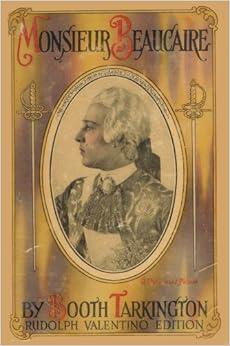 I was surprised to learn recently that in 1924 Grosset & Dunlap published a "Rudolph Valentino Edition" of Booth Tarkington's novel Monsieur Beaucaire. Valentino starred in the movie version. I don't know if this was the first movie tie-in edition of a book, but it was earlier than I had imagined. The Valentino edition included stills from the movie in its pages and probably was very popular at the time.
I was surprised to learn recently that in 1924 Grosset & Dunlap published a "Rudolph Valentino Edition" of Booth Tarkington's novel Monsieur Beaucaire. Valentino starred in the movie version. I don't know if this was the first movie tie-in edition of a book, but it was earlier than I had imagined. The Valentino edition included stills from the movie in its pages and probably was very popular at the time.Movie tie-ins are now commonplace. They help sell more copies of the book, and if they can be published soon enough, they sell more movie tickets. It can be a win-win for both movie studios and publishers. Tie-ins aren't always a win for book readers and moviegoers, however. That's because tie-ins raise expectations that movies will closely follow the stories told in the novels. That rarely happens. Directors are forced to eliminate much of the plot and even many of the characters to fit the story into a two-hour production. In most cases they go even further and change essential elements of the story, such as by adding a love interest or by giving it a happy ending the author didn't intend.
Movie tie-ins are probably most popular with those who see the movie first, like it and then want to read the story. They may even blame the authors, rather than the movie directors, for changing the story.
 I usually avoid movie tie-ins when I can. In a brief tour of my library, I found just three tie-ins, although I am sure there must be others hidden away somewhere. I have a paperback of Sebastien Japrisot's A Very Long Engagement with actress Audrey Tautou on the cover. I love this French film, but I have yet to read the novel, so I am yet to be disappointed.
I usually avoid movie tie-ins when I can. In a brief tour of my library, I found just three tie-ins, although I am sure there must be others hidden away somewhere. I have a paperback of Sebastien Japrisot's A Very Long Engagement with actress Audrey Tautou on the cover. I love this French film, but I have yet to read the novel, so I am yet to be disappointed.I own two copies of The Princess Bride, one of which is a paperback with a still from the movie on the cover. I like both the movie and the book, but I like the movie better. I also have a paperback of William Eastlake's Castle Keep showing Burt Lancaster with his eye patch from the film. I can remember seeing the movie first back in the 1960s, then going out to find a copy of the book, which I also liked.
In my mind I like to try to keep movies separate from the novels upon which they were based simply because they are often so very different. This isn't easy to do, however, because the film images are so powerful. You can read the novel, then see the movie and become convinced in your head that the story you saw on the screen was the same story you read. I think it's probably better to read the book first, but I'm sure you could also argue the other way.
No comments:
Post a Comment